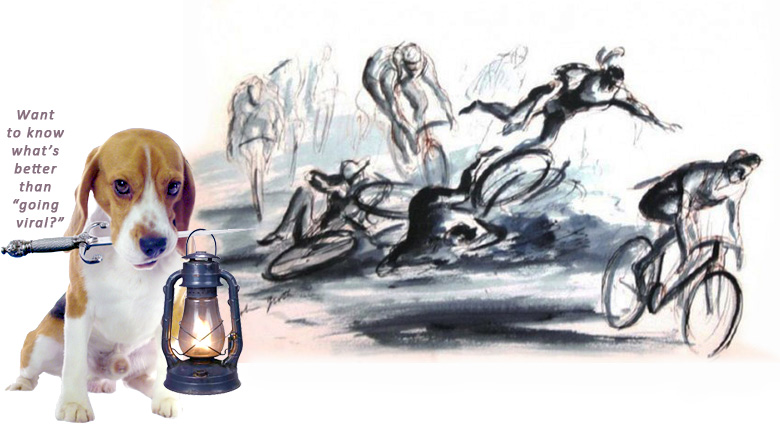
Real experts in online marketing rarely use the phrase “going viral,” because it has no agreed-upon definition. Instead, they talk about “Discovery Content” and “Community Content.”
To understand Discovery Content, just look at anything posted by BuzzFeed or any of the other organizations whose principal income is generated by the companies who sponsor their clickbait.1
But not all Discovery Content is shallow and vacuous.
The goal of Discovery Content is to generate a click. (The headline is the key.) If a customer finds something satisfying on the other side of that click, they’re happy-happy-happy. And if your only goal was to get more people to “discover” your website, then you’re happy, too.
A visitor who “discovers” your website – but never returns – has no value beyond stroking your ego, unless
1. their visit brought you ad revenue, or
2. they purchased something on which you made a profit, or
3. they told other people about you.
Used correctly however, Discovery Content brings newcomers to your website where they will “discover” Community Content that truly speaks to them.
It is Community Content that will bring them back again.
We’re talking about Targeting Through Copy Writing rather than Targeting Through Media Selection.
Today’s Monday Morning Memo is an example of Discovery Content. That headline: The Truth About Going Viral, will doubtless generate a lot more first-time visitors than usual. The Community Content these visitors will find includes the Archives of the Monday Morning Memo, the Subscribe button, the Rabbit Hole of Indy Beagle, and all the free Downloads accessible through the nav panel.
Discovery Content attracts first-time visitors.
It brings people to your website.
Community Content builds a tribe.
It makes them feel like they belong.
But these ideas aren’t new.
In the wild and woolly world of mass media, the Loss Leader was the original Discovery Content.
The advertiser offering a Loss Leader hoped that by selling something at a loss they would explode store traffic and this horde of new visitors would then “discover” the wonder of their store and buy other items at full price.
Today’s online marketers call the Loss Leader a “tripwire.” 2
But I prefer to target through copy writing, which is why I use full-price Feature Items to attract new members of a tribe instead of cut-rate Loss Leaders that attract grave robbers, vampires, coupon clippers, discount addicts, freebie Freddies, and every other variety of Twitchy Little Bastard.
A Case History of Targeting Through Copy Writing:
Shreve and Company has been part of the ritzy Union Square district of San Francisco since the California Gold Rush more than 165 years ago. Shreve routinely sells jewelry items that cost hundreds of thousands of dollars. Due to the rich history of this store and the impact of all the world’s-finest brands they carry, they could easily be perceived as stodgy, snooty and overpriced. But they aren’t.
In the radio campaign for Shreve, 5th generation Shreve jeweler Lawrence “Ren” Schiffman, a young and definitely NOT-stodgy, NOT-snooty 20-something has become the official spokesperson for the family store. Ren’s dad is a jeweler, his grandad was a jeweler, his great grandad was a jeweler, and his great-great grandad was a jeweler. Credibility and history wrapped in youth and style.
Here’s the Example:
REN: Polo is “the sport of kings.”
ROY: And in the go-go 80’s, the Paiget Polo was the watch of kings.
REN: Having a Piaget Polo was even cooler than having a phone in your car.
ROY: [reflectingly] I remember those days.
REN: The new Polo “S” is satin-finished stainless steel.
ROY: [surprised] And the shape of that dial is fascinating!
REN: What do you think about the pinstripes?
ROY: I LOVE the pinstripes.
REN: This ultra-modern Polo “S” is going to become a classic just like its predecessor.
ROY: Wait a minute. I didn’t know Piaget made a luxury watch in stainless steel.
REN: This is the first one in 60 years.
ROY: It’s definitely distinctive.
REN: Vintage and Futuristic at the same time.
ROY: Vintage and Futuristic… just like Shreve and Company… luxury timepieces, fine designers, and flawless diamonds.
REN: Come and see the new Paiget Polo “S” at 150 Post Street off Union Square, or see it on
our blog at Shreve.com
ROY: He’s Ren Schiffman.
REN: And I’m looking forward to shaking your hand.
This ad gives you a specific, entry-priced item to consider, but it offers no discount or bribe that might attract a Twitchy Little Bastard looking for something other than what Shreve sells.
The benefit of a Feature Item isn’t measured only through the immediate traffic it brings, but through the expanded perception of the brand. Listeners to the Ren Schiffman campaign are making new decisions about Shreve based on the new information Ren provides and the style in which he provides it. Win/Win/Win.
Targeting Through Copy Writing is much more difficult, effective, sophisticated and refined than Targeting Through Media Selection.
You’ll find a treasure trove of additional details regarding this case history on page 1 of the rabbit hole. A second radio ad – riskier and funnier – that demonstrates “targeting through copy writing” is waiting for you on page 2. Just click the image of Indy Beagle at the top of this page and you’re in.
Aroo.
Roy H. Williams
A NEW CLASS at WIZARD ACADEMY!
Chris Maddock and Daniel Whittington
will help you Expand Your Brand November 8-9.
Good friends know all your stories.
Great friends were there when it happened.
Be there when it happens.
The Wizard Academy reunion is October 7th.
1 “Sponsored content” can be as innocent as a company’s logo posted in the corner of an entertaining video that has nothing to do with that company or its products. But more often, sponsored content is an ad disguised as a news story; what used to be called an advertorial.
2 Online marketers are using the Loss Leader “tripwire” in a more calculated and sophisticated manner than their brick-and-mortar counterparts. What they’re doing differently – and how it could be adapted to traditional retail – is the subject of a future Monday Morning Memo. – RHW
Stephanos Evangelinos opened a small storefront in the New York borough of Queens in 1981. He now makes more bagels than anyone in the world. He and his crew produce half of all the bagels consumed daily in the greater New York area. And as you know, those New Yorkers eat a lot of bagels. Roving Reporter Rotbart’s All-American tale of overcoming odds and obstacles is one worth chewing on, with or without cream cheese, at MondayMorningRadio.com
